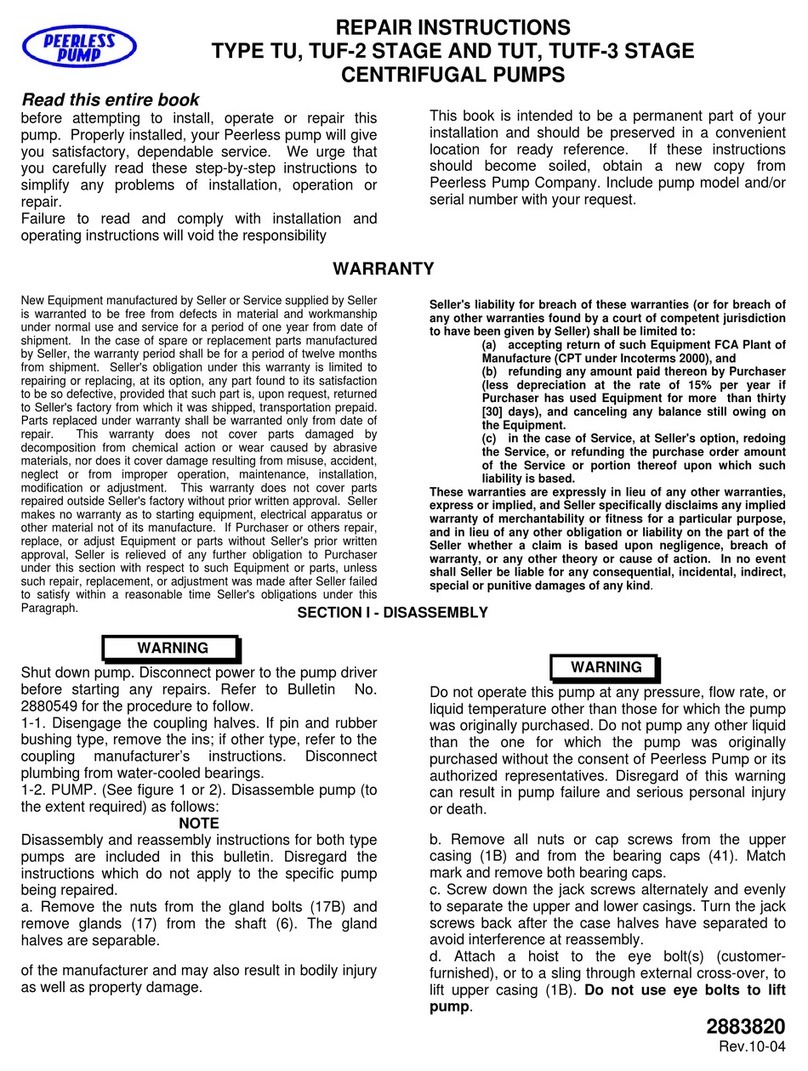
English (US) Installation and operating instructions
Original installation and operating instructions
Table of contents
1.
General information ........................2
Limited warranty ...........................2
Hazard statements..........................3
Notes ..................................3
Target group. .............................3
General safety warnings ......................3
Material safety data sheet .....................4
Noise level. ..............................4
2. Identification .............................7
2.1 Nameplate ...............................7
2.2 Certifications .............................7
2.3 Pump size and model ........................7
2.4 Type key for in-line fire pump ..................9
3. Receiving the product ......................9
3.1 Unpacking the product ......................9
3.2 Transporting the product .....................9
3.3 Inspecting the product. .....................9
3.4 Scope of delivery ..........................9
3.5 Handling and storing the product after delivery........9
4.Installing the product ......................9
4.1 Factory support ...........................9
4.2 Location ...............................9
4.3 Foundation .............................10
4.4 Installation preparations. .....................10
4.5 Mechanical installation ......................12
4.6 Pipes and connections ......................12
4.7 Lubrication, priming and cooling systems ...........13
4.8 Electrical installation ........................13
4.9 Control, monitoring, and alarm equipment. ..........13
5. Starting up the product .....................13
5.1 Lubricating the pump .......................13
5.2 Checking rotation. .........................14
5.3 Check list ..............................14
5.4 Starting up the product ......................14
6.Service ...............................15
6.1 Maintenance ............................15
6.2 Maintenance schedule ......................15
6.3 Recommended spare parts ...................16
6.4 Consumables ............................16
6.5 Tightening torques .........................16
6.6 Dismantling the pump .......................16
6.7 Wear ring ..............................17
6.8 Replacing the wear ring ......................17
6.9 Inspecting the product. ......................17
6.10 Repairing the product .......................17
6.11 Assembling the pump .......................17
6.12 Accessories .............................18
7. Storage / handling the product ................18
7.1 Storage. ...............................18
7.2 Handling the product .......................19
7.3 Frost protection ...........................19
8. Fault finding / Fault finding the product ..........20
8.1 Parts list and sectional drawings ................22
9. Disposing of the product ....................22
1. General information
1.1 Limited warranty
New equipment manufactured by seller or service supplied by seller
is warranted to be free from defects in material and workmanship
under normal use and service for a minimum of twelve (12) months
from date of installation, eighteen (18) months from date of
shipment, unless otherwise stated in product warranty guide
(available upon request). In the case of spare or replacement parts
manufactured by seller, the warranty period shall be for a period of
twelve months from shipment. Seller's obligation under this
warranty is limited to repairing or replacing, at its option, any part
found to its satisfaction to be so defective, provided that such part
is, upon request, returned to seller's factory from which it was
shipped, transportation prepaid. Parts replaced under warranty shall
be warranted for twelve months from the date of the repair, not to
exceed the original warranty period. This warranty does not cover
parts damaged by decomposition from chemical action or wear
caused by abrasive materials, nor does it cover damage resulting
from misuse, accident, neglect, or from improper operation,
maintenance, installation, modification or adjustment. This warranty
does not cover parts repaired outside seller's factory without prior
written approval. Seller makes no warranty as to starting
equipment, electrical apparatus or other material not of its
manufacture. If purchaser or others repair, replace, or adjust
equipment or parts without seller's prior written approval, seller is
relieved of any further obligation to purchaser under this paragraph
with respect to such equipment or parts, unless such repair,
replacement, or adjustment was made after seller failed to satisfy
within a reasonable time seller's obligations under this paragraph.
Seller's liability for breach of these warranties (or for breach of any
other warranties found by a court of competent jurisdiction to have
been given by seller) shall be limited to: (a) accepting return of such
equipment exw plant of manufacture, and (b) refunding any amount
paid thereon by purchaser (less depreciation at the rate of 15% per
year if purchaser has used equipment for more than thirty [30]
days), and canceling any balance still owing on the equipment, or
(c) in the case of service, at seller's option, redoing the service, or
refunding the purchase order amount of the service or portion
thereof upon which such liability is based. These warranties are
expressly in lieu of any other warranties, express or implied, and
seller specifically disclaims any implied warranty of merchantability
or fitness for a particular purpose, and in lieu of any other obligation
or liability on the part of the seller whether a claim is based upon
negligence, breach of warranty, or any other theory or cause of
action. In no event shall seller be liable for any consequential,
incidental, indirect, special or punitive damages of any kind. For
purposes of this paragraph, the equipment warranted shall not
include equipment, parts, and work not manufactured or performed
by seller. With respect to such equipment, parts, or work, seller's
only obligation shall be to assign to purchaser the warranties
provided to seller by the manufacturer or supplier providing such
equipment, parts or work. No equipment furnished by seller shall be
deemed to be defective by reason of normal wear and tear, failure
to resist erosive or corrosive action of any fluid or gas, purchaser's
failure to properly store, install, operate, or maintain the equipment
in accordance with good industry practices or specific
recommendations of seller, including, but not limited to seller's
installation and operation manuals, or purchaser's failure to provide
complete and accurate information to seller concerning the
operational application of the equipment.
4




























